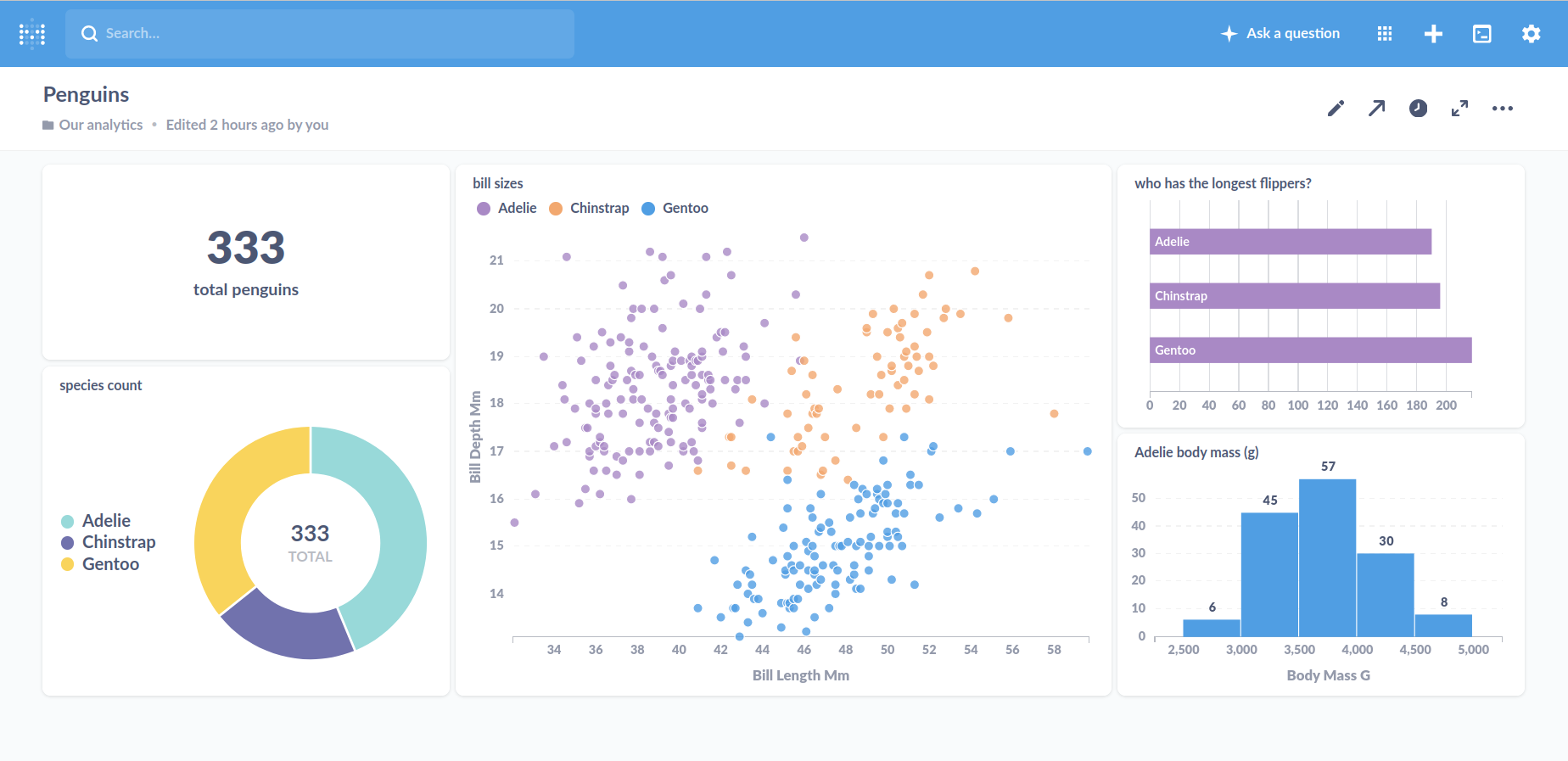Penguin Dashboard#
In this tutorial, you will build a dashboard like this one using Metabase and Docker Compose:

penguin dashboard#
The data are 333 penguins stored in the file penguins.csv
1. Install Docker and Docker Compose#
Please follow the instructions on the
On Linux, you may want to follow the postinstall
guide
so that you don’t need to type sudo every time you want to run a
docker command.
On Windows, the installation can be tricky without Windows Pro. If you need to use WSL2 installation, lease stick to the WSL2 install guide. Also check out the [Checklist by @bonartm](https://gist.github.com/bonartm/2b754a61218daa9da64e94da620d8f18).
On MacOS, the installation is rather straightforward.
Run on your terminal:
docker run hello-world
You should see that docker downloads a container image and prints a welcome message.
Hello from Docker!
This message shows that your installation appears to be working correctly.
To generate this message, Docker took the following steps:
...
2. Create a database container#
Create a new project folder. In that folder, create a file
docker-compose.yml with the following:
version: '3'
services:
pg_database:
image: postgres:13.0
environment:
- POSTGRES_PASSWORD=1234
- POSTGRES_USER=postgres
- POSTGRES_DB=pingubase
Now run the container. Go to your project folder on the terminal and type:
docker-compose up
At the end of a lot of output, you should see the message:
database system is ready to accept connections
Stop docker-compose with Ctrl-C.
3. Add a table#
To add the data, you need to create a table first. Create a folder
sql_init/ and add a file penguins.sql:
CREATE TABLE IF NOT EXISTS penguins (
id SERIAL PRIMARY KEY,
species VARCHAR(12),
bill_length_mm NUMERIC
);
You need to tell docker to share this folder with the postgres
container. The docker postgres image will execute all SQL scripts in
the folder /docker-entrypoint-initdb.d when the container is started
for the first time.
Add the following lines to docker-compose.yml in the pg_database
section:
volumes:
- ./sql_init/:/docker-entrypoint-initdb.d
Now tear down the container and recreate it with:
docker-compose down
docker-compose up
You should see the CREATE TABLE statement finish without errors in
the output.
Stop the container again.
4. Add data#
The database is still empty. To fill it with data, you need to do a few things:
Add the CSV file :::file ../images/penguins.csv to the
sql_init/folder (wherepenguins.sqlis already).Inspect the columns in the CSV file and what type they have
Add the necessary columns to the
CREATE TABLEstatementTear down the container with
docker-compose down. Otherwise the.sqlscript won’t be executed.Add the new columns to the
COPYcommand below (but leave awayid):
SQL command to load data:
COPY penguins (species, bill_length_mm, ...)
FROM '/docker-entrypoint-initdb.d/penguins.csv' CSV HEADER DELIMITER ';';
Now you can start the container again. You should see ``COPY 333`` somewhere in the output.
5. Inspect the data#
Let’s make sure that the penguins are really in the database. Keep the
container running (or restart it with docker-compose up).
Now open a second terminal and go to your project folder. There, we execute the interactive postgres command line via docker:
docker-compose exec pg_database psql -U postgres -d pingubase
If it works, type:
SELECT * FROM penguins;
You should be able to scroll through a table with 333 rows.
6. The Dashboard Container#
The Metabase dashboard will run in a
separate container. In this section, you need to edit the
docker-compose.yml file so that it starts two containers instead of
one.
First, create a new folder metabase_data/ in your project directory.
This folder will contain your dashboard, so that your settings are
preserved even when you delete the container with
docker-compose down .
Add the new container by pasting the following code (dashboard
should be at the same indentation level as pg_database):
dashboard:
image: metabase/metabase:latest
ports:
- 3000:3000
volumes:
- ./metabase_data/:/metabase-data
environment:
- MB_DB_FILE=/metabase-data/metabase.db
depends_on:
- pg_database
Then restart the service with
docker-compose up
Go to your broser on http://localhost:3000. You should see the Metabase welcome screen.
7. Setting up Metabase#
Before you can create a dashboard, you need to tell Metabase who you are and where the data is. First, create an account with a name, email and password (it does not have to be your real email).
Next, configure the database. You need:
The database type: PostgreSQL
Name: any (this name is only used by Metbase)
Host:
pg_database(the name of the other container)Port: `5432
Database name:
pingubase(the one specified indocker-compose.yml)Password: The password you specified in
docker-compose.yml
You find a detailed Setup Guid in the Metabase docs.
If everything works, you should get to the main screen of Metabase, where you can already see your penguin database. There are multiple buttons where you can create tables, plots and add them to a dashboard.
Don’t forget to press the “Save” button after editing your plots and the dashboard!
8. More security with and .env file#
If everything works until here, you can create nice dashboards for your
own data. But there is still a major flaw: You shouldn’t publish your
code on GitHub, because it contains the database password (and 1234
is not a good password anyway).
To increase security and make your application more flexible, you could
move some of the settings to environment variables. Create a file
called .env in your project folder. Add the line
POSTGRES_PASSWORD=1234
Now, open docker-compose.yml in your editor and change the line with
the password to
- POSTGRES_PASSWORD=${POSTGRES_PASSWORD}
It now should use the environment variable from .env automatically.
You can check your configuration for errors with:
docker-compose config
When you run the app again with docker-compose up, you should see
the same dashboard as before.
Try moving other environment variables to .env as well.
Have fun building dashboards!
9. Extra hints#
Here is a complete list of all files in the project folder (the metabase.db files are created automatically):
pingubase_project/
docker-compose.yml
metabase_data/
metabase.db/
metabase.db.mv.db
metabase.db.trace.db
sql_init/
penguins.csv
penguins.sql